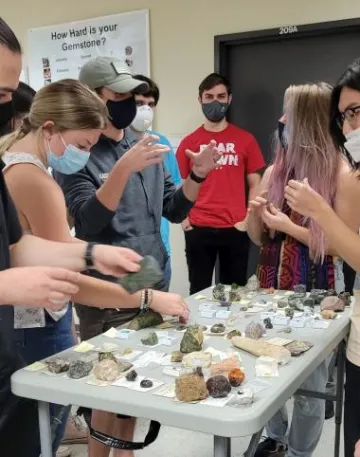October 2021
The Fall semester 2021 began with a bang at the end of August, with it bringing the start of a brand-new series of gem science classes. Eric Fritz, Director of the Alfie Norville Gem & Mineral Museum and one of the professors in charge of teaching the first set of students, shares his thoughts.
CATALYST: What are you most excited about introducing gem science to students?
FRITZ: Gemology trade certifications rely on hands on, practical experience. I, alongside museum curator Susan Leib, have engaged students with an opportunity to see, touch, and analyze a wide variety of samples from the museum collection—as well as from private collaborations. How can you learn if you are not seeing gems of similar quality to those the trade demands?
CATALYST: In your words, why is gem science an important topic to learn about?
FRITZ: Gemology is deeply rooted in science but traditionally not always viewed as such. The courses offered will bring science to the front of a multibillion-dollar gem and jewelry industry, one that is thriving in the gem shows right here in Tucson. Often, a gemstone requires backwards engineering to determine what it is, where it originated, and what story it tells the end consumer. This is all driven by value, as certain geographical areas yield stones of much greater costs. Students can study minerals, fashioned by man, and open a new discipline of research, answering questions that have long remained a mystery.

CATALYST: How will a gem science emphasis help fill out the UArizona earth science curricula?
FRITZ: What student studying earth sciences would not be drawn to the beauty and wonder of gemstones? Gems, much like their mineral counterparts, have intrigued man for millennia. The new gem science courses will allow students to understand real world conditions, in turn better preparing them for a career after graduation. Countless opportunities exist in research, mining, trade, and retail, as well as in advanced degree post-doctoral research. Opportunities will also open for those in mining career paths, since many gem deposits are still being discovered and the need for understanding formation and extraction is growing.
CATALYST: What are your thoughts on the success of the class so far? What are students saying?
FRITZ: The response has been positive yet humbling as many students have never had the opportunity to see beautiful and valuable samples. Students have been very excited to have hands-on exposure to gems, minerals, and testing equipment. Our goal is to teach them with what they might expect to encounter if they pursue gem science as a career.
CATALYST: Have there been any challenges with starting up a brand-new class?
FRITZ: When we did not yet know whether we could teach in-person, we had prepared for a series of Zoom demonstrations, if necessary, although it is not the same as learning via tactile touch. In the past, my co-presenter, Susan Leib, has taught mineralogy and I myself have taught gemology. The two disciplines have actually meshed together nicely. We select the theory together and then interweave mineral specimens and their matching gem counterparts. Some of the stones the students use to test do not give ideal results…very much like you expect in the trade.
CATALYST: What do the students have to look forward to next semester?
FRITZ: A comprehensive Gem Science Track has been formulated by Dr. Ananya Mallik, the RealReal Endowed Chair. We hope Geosciences see the Alfie Norville Gem & Mineral Museum as a useful educational resource, as we have a fully equipped Gem and Mineral classroom and are continually putting together teaching sets from our collection. Plans from the museum are to build out an active research lab, accessible to students in all stages of their studies.

